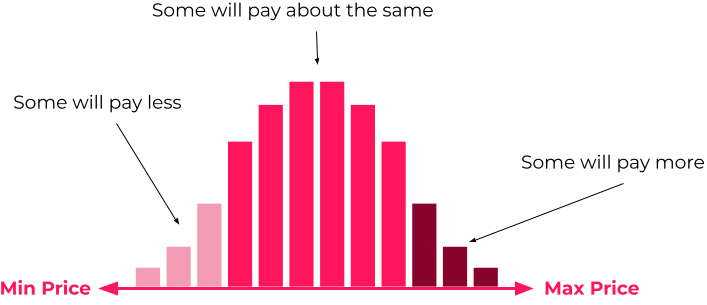You will find the answers to the following questions in this article:
1. How frequently can prices change under Dynamic Pricing?
2. Does Dynamic Pricing always result in higher prices for customers?
3. Is it possible to have different pricing strategies for different products of categories?
4. Is there a maximum or minimum limit for price fluctuations in Dynamic Pricing?
5. What benefits does Dynamic Pricing offer to businesses?
6. How can customers benefit from Dynamic Pricing?
7. What are some potential drawbacks or challenges associated with Dynamic Pricing?
8. Does Dynamic Pricing enable price discrimination?
9. In which industries is Dynamic Pricing commonly implemented?
10. Are there any regulations or guidelines governing Dynamic Pricing?
1. How frequently can prices change under Dynamic Pricing?
The demand-driven or time-based pricing strategies can be updated every 15 minutes, taking into account changes in demand and your configured price steps. If there is a significant number of tickets sold within the first 10 minutes, the prices will adjust accordingly. However, if there are no significant changes, the prices may remain stable or undergo only slight adjustments. It is worth noting that the weather forecast is updated every hour, providing additional information that can potentially influence the pricing strategy.
2. Does Dynamic Pricing always result in higher prices for customers?
No, dynamic pricing does not always result in higher prices for customers. The concept of dynamic pricing means that while some customers may pay more, others have the opportunity to pay less. It introduces the possibility of lower prices as well. However, dynamic pricing tends to encourage advance planning, as prices may be higher for last-minute decisions. The dynamic nature of the pricing strategy allows for both fluctuations in pricing and the potential for savings, depending on factors such as demand, timing, and customer behavior.
3. Is it possible to have different pricing strategies for different products of categories?
4. Is there a maximum or minimum limit for price fluctuations in Dynamic Pricing?
In Dynamic Pricing, each product has its own pricing settings, and you have the ability to set custom price ranges for each product individually. Rest assured, the prices will remain within the specified ranges you have set. This ensures that there are limits in place to prevent prices from going beyond the defined maximum or minimum thresholds. Therefore, you have control over the extent of price fluctuations and can establish boundaries to ensure pricing remains within your desired range.
5. What benefits does Dynamic Pricing offer to businesses?
Dynamic Pricing provides several benefits to businesses. By implementing dynamic pricing strategies, businesses can encourage visitors to plan their visits in advance. This leads to a more predictable number of visitors, allowing businesses to better allocate their resources, including staff and other necessary facilities. With a clearer understanding of visitor demand, businesses can optimize their cost margins and make more informed decisions regarding pricing and resource management. Overall, dynamic pricing helps businesses improve their operational efficiency and financial performance.
6. How can customers benefit from Dynamic Pricing?
Customers can benefit from Dynamic Pricing in several ways. Firstly, dynamic pricing introduces the opportunity for customers to pay less for attractions or services that may have been otherwise unaffordable. This allows them to enjoy experiences at a discounted rate. Additionally, dynamic pricing encourages customers to plan their visits in advance, providing them with the advantage of securing lower prices by booking early. By planning ahead, customers have the opportunity to take advantage of potential savings and ensure their preferred dates and times are available. Overall, dynamic pricing offers customers the chance to access affordable pricing options and encourages them to make informed decisions while planning their outings or purchases.
7. What are some potential drawbacks or challenges associated with Dynamic Pricing?
While Dynamic Pricing offers numerous benefits, there are also potential drawbacks and challenges to consider. Here are a few:
Perception of unfairness: Dynamic Pricing can sometimes be perceived as unfair if customers feel they are paying higher prices due to factors beyond their control, such as high demand or time constraints.
Lack of transparency: Customers may find it challenging to understand the pricing algorithm and how prices are determined, leading to confusion or skepticism about the pricing strategy.
To address these challenges, businesses implementing Dynamic Pricing should focus on maintaining transparency, clear communication, and ensuring that the benefits outweigh the drawbacks for both the business and its customers.
8. Does Dynamic Pricing enable price discrimination?
At Convious, we vehemently oppose unfair price discrimination. Our algorithms are designed to ensure that all visitors receive the same pricing at any given moment. Pricing adjustments occur over time but are not personalized for individual customers. We prioritize maintaining fairness and consistency in pricing for all visitors to provide an equitable experience.
9. In which industries is Dynamic Pricing commonly implemented?
In reality, dynamic pricing is already utilized across various industries through special offers and discounts. However, the flight and hospitality industry were pioneers in automating dynamic pricing and making it visible to customers. Although this approach was not initially widespread, it has provided increased transparency and fairness for visitors. Convious is pleased to extend this practice to the leisure industry, bringing the benefits of dynamic pricing to a broader range of businesses and customers.
10. Are there any regulations or guidelines governing Dynamic Pricing?
While there may not be specific regulations or guidelines governing Dynamic Pricing in all jurisdictions, it is important to prioritize transparency and trust when implementing such pricing strategies. Communicating the key rules and principles of pricing to your customers is advisable. Encourage them to book in advance and take advantage of less busy days, promoting a fair and efficient distribution of visitors. By providing clear information and incentives, you can foster a sense of transparency and encourage customers to make informed decisions while enjoying the benefits of Dynamic Pricing.

